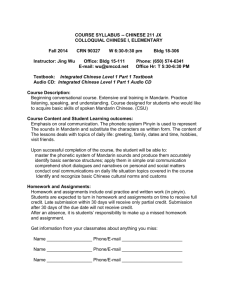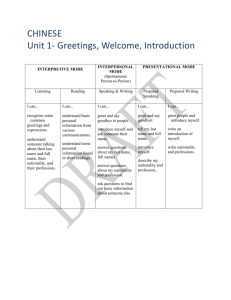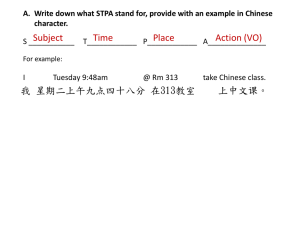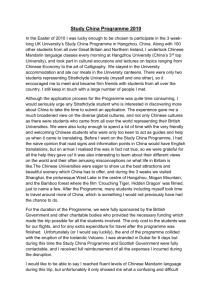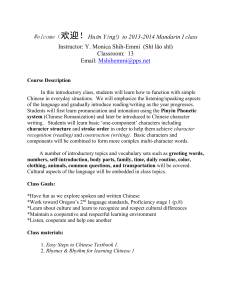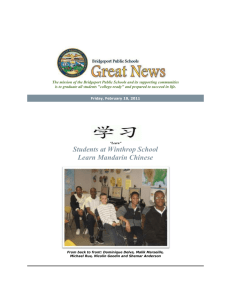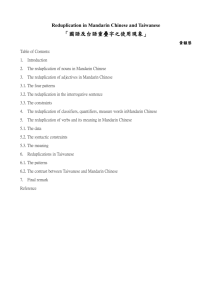Haiyan Wang December 5th Teaching Plan Sentence
advertisement
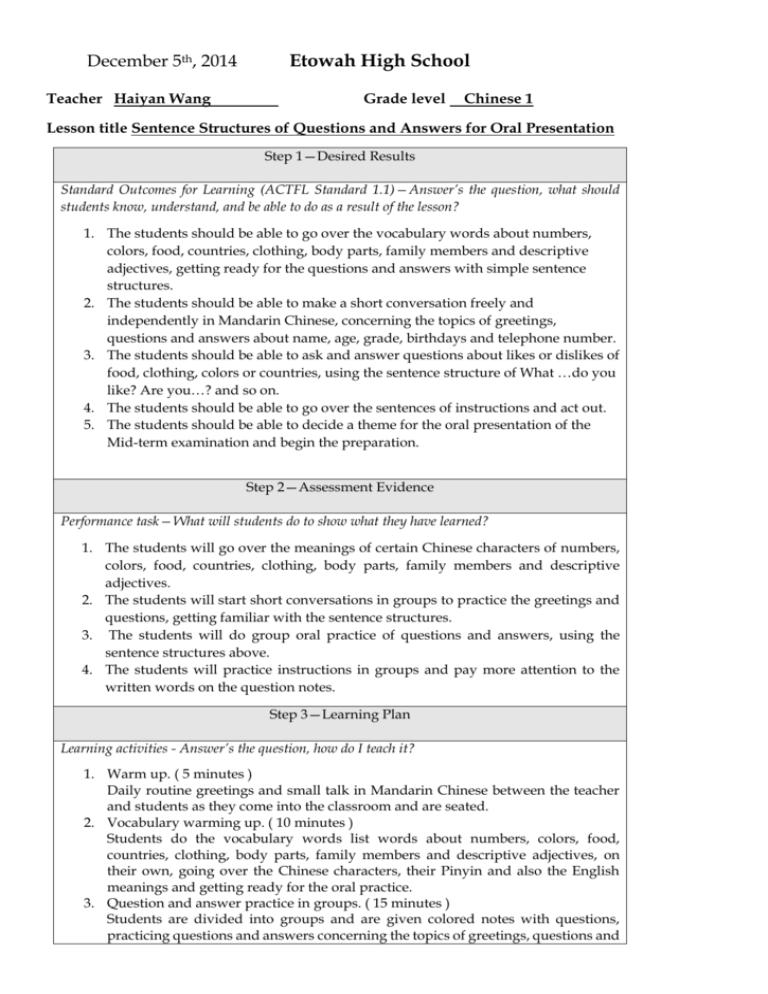
December 5th, 2014 Teacher Haiyan Wang Etowah High School Grade level Chinese 1 Lesson title Sentence Structures of Questions and Answers for Oral Presentation Step 1—Desired Results Standard Outcomes for Learning (ACTFL Standard 1.1)—Answer’s the question, what should students know, understand, and be able to do as a result of the lesson? 1. The students should be able to go over the vocabulary words about numbers, colors, food, countries, clothing, body parts, family members and descriptive adjectives, getting ready for the questions and answers with simple sentence structures. 2. The students should be able to make a short conversation freely and independently in Mandarin Chinese, concerning the topics of greetings, questions and answers about name, age, grade, birthdays and telephone number. 3. The students should be able to ask and answer questions about likes or dislikes of food, clothing, colors or countries, using the sentence structure of What …do you like? Are you…? and so on. 4. The students should be able to go over the sentences of instructions and act out. 5. The students should be able to decide a theme for the oral presentation of the Mid-term examination and begin the preparation. Step 2—Assessment Evidence Performance task—What will students do to show what they have learned? 1. The students will go over the meanings of certain Chinese characters of numbers, colors, food, countries, clothing, body parts, family members and descriptive adjectives. 2. The students will start short conversations in groups to practice the greetings and questions, getting familiar with the sentence structures. 3. The students will do group oral practice of questions and answers, using the sentence structures above. 4. The students will practice instructions in groups and pay more attention to the written words on the question notes. Step 3—Learning Plan Learning activities - Answer’s the question, how do I teach it? 1. Warm up. ( 5 minutes ) Daily routine greetings and small talk in Mandarin Chinese between the teacher and students as they come into the classroom and are seated. 2. Vocabulary warming up. ( 10 minutes ) Students do the vocabulary words list words about numbers, colors, food, countries, clothing, body parts, family members and descriptive adjectives, on their own, going over the Chinese characters, their Pinyin and also the English meanings and getting ready for the oral practice. 3. Question and answer practice in groups. ( 15 minutes ) Students are divided into groups and are given colored notes with questions, practicing questions and answers concerning the topics of greetings, questions and answers about name, age, grade, birthdays and telephone number, using the sentence structures above. Make sure all of them take turns to ask and answer different questions to get prepared for a short conversation freely and independently in Mandarin Chinese. 4. Group practice of sentence structures. ( 15 minutes) Students are given colored notes with questions and instructions, getting familiar with the sentence structures, asking and answering questions about likes or dislikes of food, clothing, colors or countries, using the sentence structure of What …do you like? Are you…? and so on. 5. Students have a discussion, decide a theme for the oral presentation of the Midterm examination and begin the preparation. ( 10 minutes ) Step 4—Reflection What happened during my lesson? What did my students learn? How do I know? What did I learn? How will I improve my lesson next time? 1. The question notes in the group oral practice helped them a lot to get familiar with both the vocabulary words and the sentence structures. 2. Some of the students were still struggling with the characters on the question notes and relied too much on the Pinyin. 3. Differentiated instruction was helpful in the group practice, especially for the top students and those who need more practice to keep up with the others. 4. More interesting topics for the oral presentation should have been provided as more options to make them more interested in the participation.
